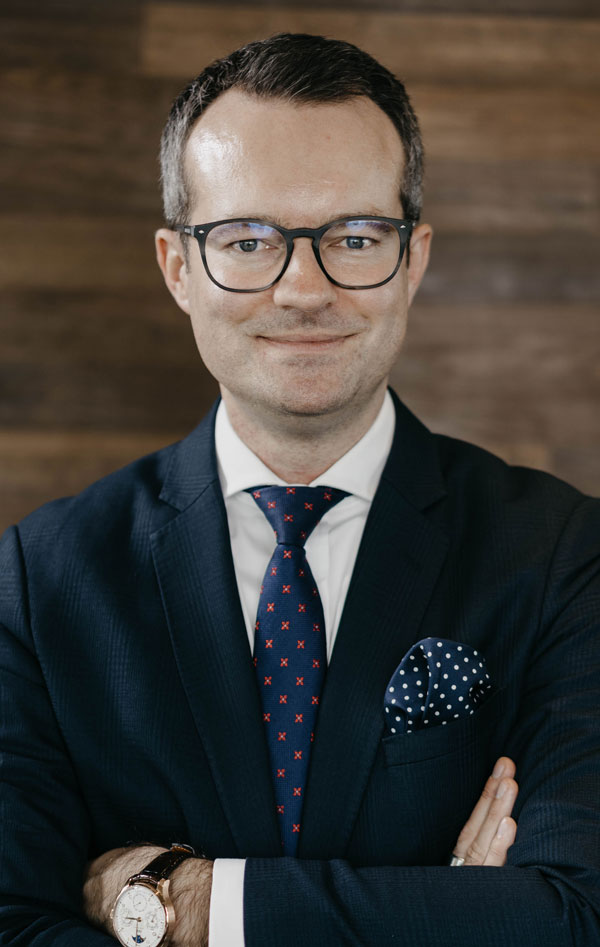KONSTANTIN WYSER, partner and pensions expert at swisspartners, talks about the challenges of the Swiss 3-pillar pension system and the exciting opportunities available to higher earners through the occupational pension scheme.
Interview by Kathrin Meister.

I see some real potential in innovative concepts from the executive pension plans.”
Pragmatically speaking, I see three possible approaches to the problem. Pension benefits could be reduced. Or the mandated contributions from the working population could be increased. A third possibility would be to increase the minimum pension age, for example to 70 years. Because, let’s be honest, these days 65-year-olds are anything but “old” – many are still in such good shape that they could easily run a marathon. So why shouldn’t they continue to make themselves available to the labour market? The demand would surely be there. The problem is that all three ideas would almost certainly be met with resistance from the affected group.
Since 2005, as a result of the reform, only the portion of the annual salary below the threshold of approximately CHF 90,000 has been covered by the mandatory pension provision and converted at the current rate of 6.8%. All annual salary over CHF 90,000 is covered by the extra-mandatory pension provision – which means that the pension fund determines how high the conversion rate and interest rates are and, consequently, how high the pension payments will be. These changes resulted in an overall decrease in pension benefits for higher earners – which was a downright shock and led to a change in thinking. Until then, everyone had assumed that the pension benefits would be sufficient to ensure a consistent standard of living in old age. But that was no longer a given, and this in turn created a strong demand for expert advice.

That is correct. In principle, employers must insure pensioners in the second pillar. Traditionally, this has meant using a full insurance model with a pre-determined interest rate. And therein lies the problem. Interest rates have fallen drastically. In the extra-mandatory portion, they are often close to zero. Previously, interest and the resulting returns made up the “third contributors” to the pension fund, alongside the employer and the employee. Employees pay into the pension fund for an average of 40 years – which, with the help of the interest effect, resulted in a tidy sum over time. As a result of the low or non-existent interest rates, this is no longer the case, and hasn’t been for some time. That’s a significant problem.
There are some very exciting possibilities to be found in the second pillar. I see some real potential in innovative concepts from the executive pension plans – called the Kadervorsorge in German. These are a modern, customisable form of the common management pension funds, which are also known as “1e solutions”. A company gives all of its employees with annual salaries exceeding approximately CHF 130,000 a unique investment opportunity. Employees can take the pension savings resulting from the portion of their salary in excess of CHF 130,000 and invest it in a diversified securities portfolio based on their personal risk tolerance – with the help of a professional wealth manager, of course.

As soon as the employer selects a solution that allows employees to choose the investment strategy for the extra-mandatory portion, they immediately profit from a number of benefits that provide a higher rate of return within the scope of their occupational benefits. Firstly, employees can choose how much risk they are prepared to accept for this portion of their pension. The higher the percentage of stocks, the higher the risk – and of course, the higher the expected returns. With a high proportion of stocks – from over 50% up to a maximum of 100% – the expected rate of return is, on average, between 4–6% annually. For this portion of the occupational pension, the interest revenue is not distributed among other insured parties; each employee enjoys the full benefit of the interest, and redistribution effects are avoided. That’s why we refer to a “desolidarisation” in this case. Secondly, the employees can often determine the savings rate themselves in these flexible pension solutions. Although the employer always makes the same contribution (as part of the legal requirements), there are models that allow the employees to choose the amount that they would personally like to contribute. That opens up the possibility of saving up more money for retirement.
The low or non-existent interest rates generate low returns – a significant problem for the pension funds.”
That is a major benefit of optimising the pension savings in the second pillar. Higher earners can, where possible, make additional buy-ins to the pension fund and offset it against their taxable income. Depending on the marginal tax rate, there is a potential saving of up to 50%. And that really is a lot of money, especially for the highest earners. By comparison, the third pillar has a limit of slightly more than CHF 7,000, which offers very limited opportunities.
Yes, definitely. People could get a lot more out of their pension if we all had the opportunity to influence our pension funds within a certain set of parameters. The pension funds force everyone to use the same investment strategy. But it would be much better if each person could invest their savings as they see fit, given their personal financial situation – and yes, even in growth-oriented securities accounts, providing they are still many years away from retirement. As it stands now, because people have no control over their occupational pension, many people in Switzerland don’t even know how much money they have saved up in their retirement fund. It would be good to raise awareness about occupational pensions so that everyone can give them more thought. The more people think about the issue, the better-off they will be when they reach retirement age. More personal choice in the occupational pension scheme would increase the general population’s interest in finance and wealth-building, as well as encouraging the development of innovative pension solutions.
People could get a lot more out of their pension if we all had the opportunity to influence our pension funds within a certain set of parameters.”
They are targeted at business owners and executives in small and medium-sized enterprises who want to make their own decisions about how their pension fund is invested. The prerequisite is that the employer agrees to this model and makes it available to all higher-earning employees. In Switzerland, customisable pension fund solutions have been available since 2006, but there was no great demand for these options until just a few years ago. We would like to increase people’s awareness of the issue.
For the executive pension plans in the occupational pension, a pension foundation – known as a Vorsorgestiftung in German – is always mandatory. Consequently, we manage these solutions and portfolios in cooperation with different independent foundations. We act as wealth managers, in the same way that the pension funds do. The employee gives swisspartners the necessary mandate, after which we take on the role of wealth manager. In consultation with the insured party, we select a personalised investment strategy that is comprised of various asset classes. These are very complex investment solutions and they require personalised advisory expertise – including in terms of the actuarial and tax-related aspects. Our clients can put their trust in our expertise and many years of experience in this area.

KONSTANTIN WYSER
Partner | Wealth Management
konstantin.wyser@swisspartners.com
Photos © Karin Bischof
Aktuelle Themen und Trends aus Finanzwelt, Wirtschaftspolitik und globalem Leben – das Magazin von swisspartners bis zu viermal jährlich kostenlos in Ihrem E-Mail-Postfach.